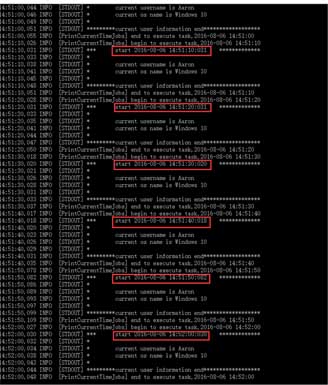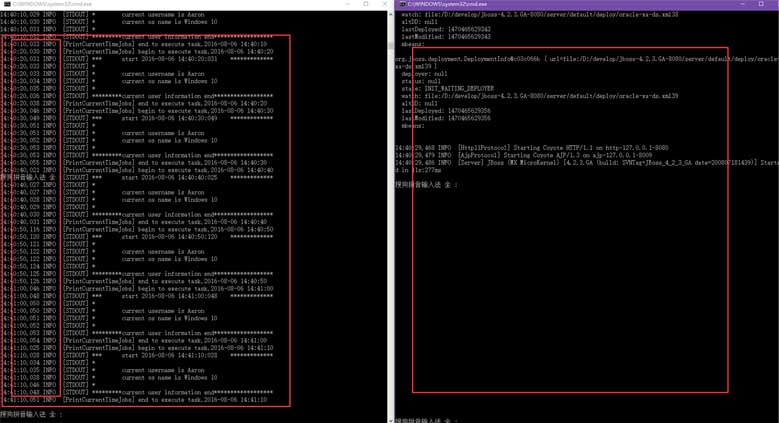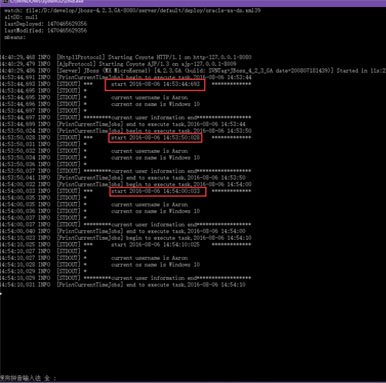问题背景
我公司是一个快速发展的创业公司,目前有200人,主要业务是旅游和酒店相关的,应用迭代更新周期比较快,因此,开发人员花费了更多的时间去更=跟上迭代的步伐,而缺乏了对整个系统的把控
没有集群之前,公司定时任务的实现方式
在初期应用的访问量并不是那么大,一台服务器完全满足使用,应用中有很多定时任务需要执行
有了集群之后,公司定时任务实现的方式
随着用户的增加,访问量也就随之增加,一台服务器满足不了高并发的要求,因此公司把应用给部署到集群中,前端通过nginx代理(应用服务器ip可能是用防火墙进行了隔离,避免了直接使用ip+端口+应用名访问的方式)。
在集群环境中,同样的定时任务,在集群中的每台机器都会执行,这样定时任务就会重复执行,不但会增加服务器的负担,还会因为定时任务重复执行造成额外的不可预期的错误,因此公司的解决方案是:根据集群的数量,来把定时任务中的任务平均分到集群中的每台机器上(这里的平均分是指以前一个定时任务本来是在一台机器上运行,先在人为的把这个任务分成几部分,让所有的机器都去执行这个人去)
目前集群中定时任务实现方式的缺陷
目前公司在集群中处理定时任务的方式不是正真的分布式处理方式,而是一种伪分布式(公司内部俗称土方法),这种方式存在一个明显的缺陷就是当集群中机器宕机,那么整个定时任务就会挂掉或者不能一次性跑完,会对业务产生严重的影响
针对缺陷的解决方案(本文的重点之处)
利用spring+quartz构建一套真正的分布式定时任务系统,经过查阅相关资料得知:quartz框架是原生就支持分布式定时任务的
开发IDE:Intellij IDEA
JDK版本:1.8
Spring版本:4.2.6
Quartz版本:2.2.1
Spring与Quartz集成配置
|
1
2
3
4
5
6
7
8
9
10
11
12
13
14
15
16
17
18
19
20
21
22
23
24
25
26
27
28
29
30
31
32
33
34
35
36
37
38
39
40
41
42
43
44
45
46
47
48
49
50
51
52
53
54
55
56
57
58
59
60
61
62
63
64
65
66
67
68
69
70
71
72
73
74
75
76
77
78
79
80
81
82
83
84
85
86
|
<?xml version="1.0" encoding="UTF-8"?><beans xmlns="http://www.springframework.org/schema/beans" xmlns:xsi="http://www.w3.org/2001/XMLSchema-instance" xmlns:context="http://www.springframework.org/schema/context" xsi:schemaLocation="http://www.springframework.org/schema/beans http://www.springframework.org/schema/beans/spring-beans-4.0.xsd http://www.springframework.org/schema/context http://www.springframework.org/schema/context/spring-context.xsd"> <context:component-scan base-package="com.aaron.clusterquartz.job"/> <bean name="dataSource" class="org.springframework.jndi.JndiObjectFactoryBean"> <!-- tomcat --> <!--<property name="jndiName" value="java:comp/env/jndi/mysql/quartz"/>--> <!-- jboss --> <property name="jndiName" value="jdbc/quartz"/> </bean> <!-- 分布式事务配置 start --> <!-- 配置线程池--> <bean name="executor" class="org.springframework.scheduling.concurrent.ThreadPoolTaskExecutor"> <property name="corePoolSize" value="15"/> <property name="maxPoolSize" value="25"/> <property name="queueCapacity" value="100"/> </bean> <bean name="transactionManager" class="org.springframework.jdbc.datasource.DataSourceTransactionManager"> <property name="dataSource" ref="dataSource"/> </bean> <!-- 配置调度任务--> <bean name="quartzScheduler" class="org.springframework.scheduling.quartz.SchedulerFactoryBean"> <property name="configLocation" value="classpath:quartz.properties"/> <property name="dataSource" ref="dataSource"/> <property name="transactionManager" ref="transactionManager"/> <!-- 任务唯一的名称,将会持久化到数据库--> <property name="schedulerName" value="baseScheduler"/> <!-- 每台集群机器部署应用的时候会更新触发器--> <property name="overwriteExistingJobs" value="true"/> <property name="applicationContextSchedulerContextKey" value="appli"/> <property name="jobFactory"> <bean class="com.aaron.clusterquartz.autowired.AutowiringSpringBeanJobFactory"/> </property> <property name="triggers"> <list> <ref bean="printCurrentTimeScheduler"/> </list> </property> <property name="jobDetails"> <list> <ref bean="printCurrentTimeJobs"/> </list> </property> <property name="taskExecutor" ref="executor"/> </bean> <!-- 配置Job详情 --> <bean name="printCurrentTimeJobs" class="org.springframework.scheduling.quartz.JobDetailFactoryBean"> <property name="jobClass" value="com.aaron.clusterquartz.job.PrintCurrentTimeJobs"/> <!--因为我使用了spring的注解,所以这里可以不用配置scheduler的属性--> <!--<property name="jobDataAsMap"> <map> <entry key="clusterQuartz" value="com.aaron.framework.clusterquartz.job.ClusterQuartz"/> </map> </property>--> <property name="durability" value="true"/> <property name="requestsRecovery" value="false"/> </bean> <!-- 配置触发时间 --> <bean name="printCurrentTimeScheduler" class="com.aaron.clusterquartz.cron.PersistableCronTriggerFactoryBean"> <property name="jobDetail" ref="printCurrentTimeJobs"/> <property name="cronExpression"> <value>0/10 * * * * ?</value> </property> <property name="timeZone"> <value>GMT+8:00</value> </property> </bean> <!-- 分布式事务配置 end --></beans> |
quartz属性文件
|
1
2
3
4
5
6
7
8
9
10
11
12
13
14
15
16
17
18
19
20
21
22
23
24
25
26
27
28
29
30
31
32
33
34
|
#============================================================================# Configure JobStore# Using Spring datasource in quartzJobsConfig.xml# Spring uses LocalDataSourceJobStore extension of JobStoreCMT#============================================================================org.quartz.jobStore.useProperties=trueorg.quartz.jobStore.tablePrefix = QRTZ_org.quartz.jobStore.isClustered = trueorg.quartz.jobStore.clusterCheckinInterval = 5000org.quartz.jobStore.misfireThreshold = 60000org.quartz.jobStore.txIsolationLevelReadCommitted = true# Change this to match your DB vendororg.quartz.jobStore.class = org.quartz.impl.jdbcjobstore.JobStoreTXorg.quartz.jobStore.driverDelegateClass = org.quartz.impl.jdbcjobstore.StdJDBCDelegate#============================================================================# Configure Main Scheduler Properties# Needed to manage cluster instances#============================================================================org.quartz.scheduler.instanceId=AUTOorg.quartz.scheduler.instanceName=MY_CLUSTERED_JOB_SCHEDULERorg.quartz.scheduler.rmi.export = falseorg.quartz.scheduler.rmi.proxy = false#============================================================================# Configure ThreadPool#============================================================================org.quartz.threadPool.class = org.quartz.simpl.SimpleThreadPoolorg.quartz.threadPool.threadCount = 10org.quartz.threadPool.threadPriority = 5org.quartz.threadPool.threadsInheritContextClassLoaderOfInitializingThread = true |
相关类说明
AutowiringSpringBeanJobFactory类是为了可以在scheduler中使用spring注解,如果不使用注解,可以不适用该类,而直接使用
SpringBeanJobFactory
|
1
2
3
4
5
6
7
8
9
10
11
12
13
14
15
16
17
18
19
20
21
22
23
24
25
26
27
28
29
30
31
32
|
package com.aaron.clusterquartz.autowired;import org.quartz.spi.TriggerFiredBundle;import org.springframework.beans.BeansException;import org.springframework.beans.factory.config.AutowireCapableBeanFactory;import org.springframework.context.ApplicationContext;import org.springframework.context.ApplicationContextAware;import org.springframework.scheduling.quartz.SpringBeanJobFactory;/** * @author * @description 使job类支持spring的自动注入 * @date 2016-05-27 */public class AutowiringSpringBeanJobFactory extends SpringBeanJobFactory implements ApplicationContextAware{ private transient AutowireCapableBeanFactory beanFactory; public void setApplicationContext(ApplicationContext applicationContext) throws BeansException { beanFactory = applicationContext.getAutowireCapableBeanFactory(); } @Override protected Object createJobInstance(TriggerFiredBundle bundle) throws Exception { Object job = super.createJobInstance(bundle); beanFactory.autowireBean(job); return job; }} |
|
1
2
3
4
5
6
7
8
9
10
11
12
13
14
15
16
17
18
19
20
21
22
23
24
25
26
27
28
29
30
31
32
33
34
35
36
|
package com.aaron.clusterquartz.job;import com.arron.util.DateUtils;import org.apache.commons.logging.Log;import org.apache.commons.logging.LogFactory;import org.quartz.JobExecutionContext;import org.quartz.JobExecutionException;import org.springframework.beans.factory.annotation.Autowired;import org.springframework.scheduling.quartz.QuartzJobBean;import java.util.Date;/** * @author * @description 一句话描述该文件的用途 * @date 2016-05-23 */public class PrintCurrentTimeJobs extends QuartzJobBean{ private static final Log LOG_RECORD = LogFactory.getLog(PrintCurrentTimeJobs.class); //这里就是因为有上文中的AutowiringSpringBeanJobFactory才可以使用@Autowired注解,否则只能在配置文件中设置这属性的值 @Autowired private ClusterQuartz clusterQuartz; protected void executeInternal(JobExecutionContext jobExecutionContext) throws JobExecutionException { LOG_RECORD.info("begin to execute task," + DateUtils.dateToString(new Date())); clusterQuartz.printUserInfo(); LOG_RECORD.info("end to execute task," + DateUtils.dateToString(new Date())); }} |
测试结果:
由于只有一台电脑,所有我开了8080和8888两个端口来测试的,上面的定时任务我设置了每10秒运行一次。
当只我启动8080端口时,可以看到控制台每隔10秒打印一条语句

两个端口同时启动的对比测试中可以看到,只有一个端口在跑定时任务

这个关了正在跑定时任务的端口后,之前的另一个没有跑的端口开始接管,继续运行定时任务

至此,我们可以清楚地看到,在分布式定时任务中(或者集群),同一时刻只会有一个定时任务运行。
整个demo地址:spring-cluster-quartz.rar
以上就是本文的全部内容,希望对大家的学习有所帮助,也希望大家多多支持服务器之家。
原文链接:http://www.cnblogs.com/aaronfeng/p/5537177.html












